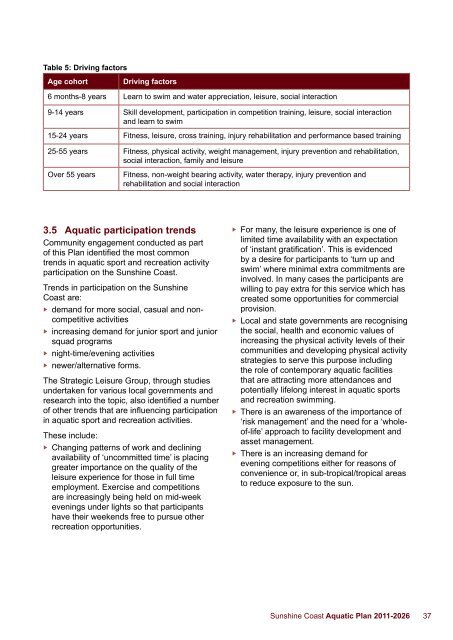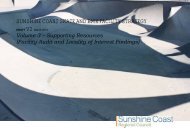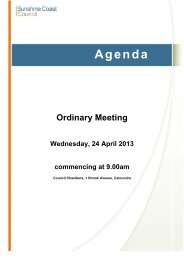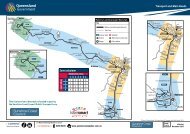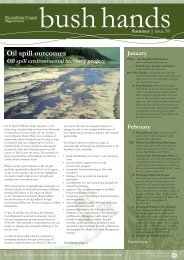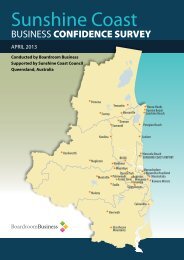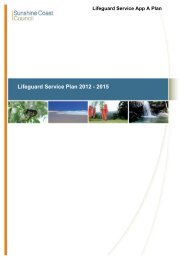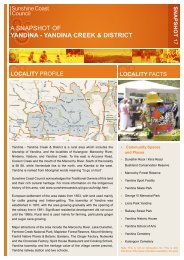Sunshine Coast Aquatic Plan 2011-2026 - Sunshine Coast Council
Sunshine Coast Aquatic Plan 2011-2026 - Sunshine Coast Council
Sunshine Coast Aquatic Plan 2011-2026 - Sunshine Coast Council
You also want an ePaper? Increase the reach of your titles
YUMPU automatically turns print PDFs into web optimized ePapers that Google loves.
Table 5: Driving factors<br />
Age cohort<br />
Driving factors<br />
6 months-8 years Learn to swim and water appreciation, leisure, social interaction<br />
9-14 years Skill development, participation in competition training, leisure, social interaction<br />
and learn to swim<br />
15-24 years Fitness, leisure, cross training, injury rehabilitation and performance based training<br />
25-55 years Fitness, physical activity, weight management, injury prevention and rehabilitation,<br />
social interaction, family and leisure<br />
Over 55 years<br />
Fitness, non-weight bearing activity, water therapy, injury prevention and<br />
rehabilitation and social interaction<br />
3.5 <strong>Aquatic</strong> participation trends<br />
Community engagement conducted as part<br />
of this <strong>Plan</strong> identified the most common<br />
trends in aquatic sport and recreation activity<br />
participation on the <strong>Sunshine</strong> <strong>Coast</strong>.<br />
Trends in participation on the <strong>Sunshine</strong><br />
<strong>Coast</strong> are:<br />
►►<br />
►►<br />
►►<br />
►►<br />
demand for more social, casual and noncompetitive<br />
activities<br />
increasing demand for junior sport and junior<br />
squad programs<br />
night-time/evening activities<br />
newer/alternative forms.<br />
The Strategic Leisure Group, through studies<br />
undertaken for various local governments and<br />
research into the topic, also identified a number<br />
of other trends that are influencing participation<br />
in aquatic sport and recreation activities.<br />
These include:<br />
►►<br />
Changing patterns of work and declining<br />
availability of ‘uncommitted time’ is placing<br />
greater importance on the quality of the<br />
leisure experience for those in full time<br />
employment. Exercise and competitions<br />
are increasingly being held on mid-week<br />
evenings under lights so that participants<br />
have their weekends free to pursue other<br />
recreation opportunities.<br />
►►<br />
►►<br />
►►<br />
►►<br />
For many, the leisure experience is one of<br />
limited time availability with an expectation<br />
of ‘instant gratification’. This is evidenced<br />
by a desire for participants to ‘turn up and<br />
swim’ where minimal extra commitments are<br />
involved. In many cases the participants are<br />
willing to pay extra for this service which has<br />
created some opportunities for commercial<br />
provision.<br />
Local and state governments are recognising<br />
the social, health and economic values of<br />
increasing the physical activity levels of their<br />
communities and developing physical activity<br />
strategies to serve this purpose including<br />
the role of contemporary aquatic facilities<br />
that are attracting more attendances and<br />
potentially lifelong interest in aquatic sports<br />
and recreation swimming.<br />
There is an awareness of the importance of<br />
‘risk management’ and the need for a ‘wholeof-life’<br />
approach to facility development and<br />
asset management.<br />
There is an increasing demand for<br />
evening competitions either for reasons of<br />
convenience or, in sub-tropical/tropical areas<br />
to reduce exposure to the sun.<br />
<strong>Sunshine</strong> <strong>Coast</strong> <strong>Aquatic</strong> <strong>Plan</strong> <strong>2011</strong>-<strong>2026</strong> 37


